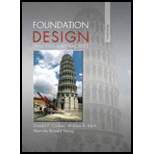
Concept explainers
After the footing in Problem 7.9 was built, the groundwater table rose to a depth of 0.5 m below the ground surface. Compute the new factor of safety against a bearing capacity failure. Compare it with the original design value of 2 and explain why it is different.
Learn your wayIncludes step-by-step video

Chapter 7 Solutions
Foundation Design: Principles and Practices (3rd Edition)
Additional Engineering Textbook Solutions
Starting Out With Visual Basic (8th Edition)
Computer Science: An Overview (13th Edition) (What's New in Computer Science)
Starting Out with Java: From Control Structures through Data Structures (4th Edition) (What's New in Computer Science)
Starting Out with Python (4th Edition)
Starting Out with C++ from Control Structures to Objects (9th Edition)
Java: An Introduction to Problem Solving and Programming (8th Edition)
- Q3. Design by LRFD maximum size side SMAW fillet welds required to develop the loads Po= 7. kips and PL-60kips for an L6x4x1/2, using E70XX electrodes steel. The member is connected on the sides of the 6-in leg and is subject to alternating loads. Draw the layout of welding. Note: 1-5/8 in. 1. All Steel sections are A36 2. The loads effect through the angle center of gravity. L6x4x1/2 Angle C.G. Parrow_forwardDesign the size side SMAW fillet welds required to develop the loads PD= 7. kips and PL=60kips for an L6x4x1/2, using E70XX electrodes steel. The member is to be connected with side welds and a weld at the end of the Q2 angle to a 5/8- inch thickness gusset plate. Balance the fillet welds around the center of gravity of the angle as shown in Figure (2). Use A36 steel. Draw the layout of welding. t=5/8 in. L 6x4x1/2 Angle C.G. P4 Figure -2-arrow_forward1. What is length of a curve if the design speed is 85mph. A grades of a road is 3% and -2% and has stopping sight distance is 820ft. Determine whether S<L or S>Larrow_forward
- 3. A crest vertical curve joins a +3% and -4% grade. Design speed is 75 mph. Length = 2184.0 ft. Station at VPI is 325+ 55.00, elevation at VPI = 260 feet. Find elevations and station for VPC (BVC) and VPT (EVC). 4. On a 0.5-mile highway segment, if the speeds of these 8 vehicles are measured as 55, 45, 40, 50, 60, 65, 70 and 65mph, respectively, what is time mean speed? What is space mean speed. 5. An observer located at point X counted 6 vehicles passing through this point during a period of 45 seconds. What is the hourly flow rate based on the observation? Good Lucky DDA 0 IN INEERI Enginearrow_forward4. On a 0.5-mile highway segment, if the speeds of these 8 vehicles are measured as 55, 45, 40, 50, 60, 65, 70 and 65mph, respectively, what is time mean speed? What is space mean speed.arrow_forwardAn observer located at point X counted 6 vehicles passing through this point during a period of 45 seconds. What is the hourly flow rate based on the observation?arrow_forward
- 1. Reaction at A 2. Shear at C 3. Bending at H :Draw the influence lines for the following functions ( (M) (M) 4. Bending at E 5. Shear at K A B H C D E K F 2 2 3 1 2 2 1.5 1.5arrow_forwardPlease provide a handwritten solution to the questionarrow_forward-K408-50/40- -840 cm- -610- K107-50/40- K101-25/50 25 -620 cm- 25 N101 (10140) K103-50/40- K109-50/40--- K102 25/50 25 620 25 N102 10/40 N103 (1040) SORU 1: Yan yana derzle ayrılmış bloklardan oluşan bir okulun bir bloğuna ait +3.20 ve +6.40 m kotları kalıp planı verilmiştir. N101, N102, N103 hacimleri sınıf olarak kullanılacaktır. Malzeme:C30/37-B500C Kaplama: mozaik karo Şantiye denetimi iyi. Dolgu (asmolen): en hafif gazbeton blok Duvar: 1 aksi kirişleri ile K104, K105, K110 ve K112 kirişleri üzerinde 25 cm lik dayanımı düşük gaz beton duvar vardır. a)Döşeme statik ve betonarme hesaplarını yaparak gerekli çizimleri veriniz. b)Tüm kirişlerin yüklerini hesaplayınız. A K105-25/50 B K106 25/50 K111 50/40 12.5 K110-50/40--- K104-50/40 Boşluk K112 25/50 12.5 22arrow_forward
 Fundamentals of Geotechnical Engineering (MindTap...Civil EngineeringISBN:9781305635180Author:Braja M. Das, Nagaratnam SivakuganPublisher:Cengage Learning
Fundamentals of Geotechnical Engineering (MindTap...Civil EngineeringISBN:9781305635180Author:Braja M. Das, Nagaratnam SivakuganPublisher:Cengage Learning Principles of Geotechnical Engineering (MindTap C...Civil EngineeringISBN:9781305970939Author:Braja M. Das, Khaled SobhanPublisher:Cengage Learning
Principles of Geotechnical Engineering (MindTap C...Civil EngineeringISBN:9781305970939Author:Braja M. Das, Khaled SobhanPublisher:Cengage Learning Principles of Foundation Engineering (MindTap Cou...Civil EngineeringISBN:9781305081550Author:Braja M. DasPublisher:Cengage Learning
Principles of Foundation Engineering (MindTap Cou...Civil EngineeringISBN:9781305081550Author:Braja M. DasPublisher:Cengage Learning Principles of Foundation Engineering (MindTap Cou...Civil EngineeringISBN:9781337705028Author:Braja M. Das, Nagaratnam SivakuganPublisher:Cengage Learning
Principles of Foundation Engineering (MindTap Cou...Civil EngineeringISBN:9781337705028Author:Braja M. Das, Nagaratnam SivakuganPublisher:Cengage Learning Construction Materials, Methods and Techniques (M...Civil EngineeringISBN:9781305086272Author:William P. Spence, Eva KultermannPublisher:Cengage Learning
Construction Materials, Methods and Techniques (M...Civil EngineeringISBN:9781305086272Author:William P. Spence, Eva KultermannPublisher:Cengage Learning Architectural Drafting and Design (MindTap Course...Civil EngineeringISBN:9781285165738Author:Alan Jefferis, David A. Madsen, David P. MadsenPublisher:Cengage Learning
Architectural Drafting and Design (MindTap Course...Civil EngineeringISBN:9781285165738Author:Alan Jefferis, David A. Madsen, David P. MadsenPublisher:Cengage Learning





